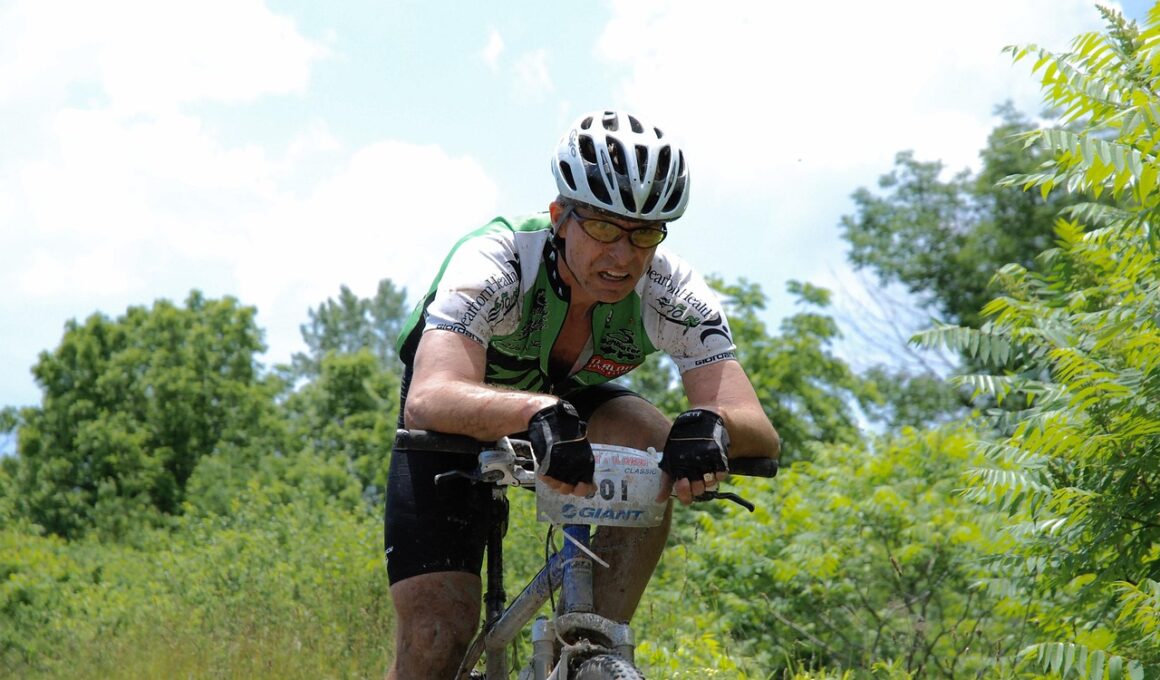Top 10 Cycling Training Plans for Endurance Improvement
Cycling is an excellent way to enhance endurance and overall fitness. If you are looking to improve your cycling endurance, there are several training plans that can help you achieve your goals. The key is to find a structured program that fits your current level while pushing your limits. Endurance training typically involves longer rides at controlled intensities, allowing your body to adapt over time. Incorporating a mix of intervals, steady-state rides, and recovery sessions can maximize your performance. These sessions will help you develop both aerobic efficiency and sustainable power. Additionally, consider your nutrition and hydration during these rides, as they play crucial roles in recovery and energy levels. One popular plan is the 12-week endurance program, which gradually increases ride duration and intensity. Many cyclists have reported significant improvements in their endurance after dedicating themselves to these structured regimens. Consider joining a local cycling club or online forums to share your experience, gather tips, and receive motivation from others who are also improving their endurance. Consistency and determination are vital components of any successful training effort.
Plan 1: Base Training Plan
The base training plan is a fundamental aspect of building cycling endurance. This plan focuses on developing aerobic capacity, ensuring that cyclists can handle longer rides without excessive fatigue. Start with a foundation of consistent, low-intensity rides that last anywhere from one to three hours. Aim for 70-80% of your maximum heart rate during these sessions. Gradually increase your training volume by 10% each week. Focus on time rather than distance initially, as this approach allows you to build a strong base. Include long, steady rides, and gradually incorporate tempo rides for variety. Movement efficiency gained during this stage can significantly enhance endurance over time. Recovery weeks are essential; after three weeks of building, reduce your volume for one week to allow your body to adapt. Don’t forget to mix in strength training, as powerful leg muscles contribute to better endurance on the bike. Lastly, consider tracking your progress with a cycling app or journal, which provides insights and encourages improvement. Each rider’s schedule may vary, but consistency in following a structured base training plan leads to optimal results.
Another effective plan is the interval training approach, which significantly enhances cardiovascular performance. Intervals involve alternating between intense effort and recovery periods, teaching your body to handle higher power outputs. This training style not only bolsters endurance but can also improve speed. Start by incorporating short intervals into your rides, lasting 30 seconds to 2 minutes, with rest intervals equal to or slightly longer than the work effort. Gradually increase the intensity and duration of these intervals. Research has shown that including high-intensity interval training (HIIT) in your regimen provides excellent results in endurance improvement. It’s important to balance these hard sessions with ample recovery to prevent burnout and injuries. As you become efficient in this method, introduce longer intervals and reduce the recovery time for an added challenge. During rides, pay close attention to your heart rate and perceived exertion to optimize your training. Many cyclists find that varying their interval pattern depending on their goals keeps the workouts interesting. Ultimately, this approach maximizes stamina while increasing overall cycling performance. Consistent engagement with interval training leads to substantial endurance gains.
Plan 3: Long Ride Commitment
Long rides play a crucial role in endurance training. By committing to longer rides each week, typically ranging from 3 to 6 hours, cyclists can significantly enhance their stamina and mental resilience. During these long rides, maintain a steady pace that allows for conversation, usually around 60-70% of maximum heart rate. It’s important to practice fueling strategies, ensuring that you consume adequate carbohydrates to maintain energy levels. Experiment with different energy foods and hydration methods to find what works best for you. Long rides also offer the opportunity to explore new routes or trails, making the training enjoyable and varied. On these rides, include short tempo efforts to simulate race conditions, which helps adaptability during longer events. Incorporating recovery days before and after these rides is essential to let your muscles recover. Gradually extend the duration of your long rides over weeks to prepare for events like gran fondos or long-distance races. Don’t forget to invest in good quality equipment, as comfort is key during extended hours on the bike. This approach creates a solid foundation for future challenges.
A popular training plan is the 10-week progressive program, tailored for seasoned cyclists looking to improve endurance. This plan focuses on systematic progression and involves gradually increasing intensity and duration. It typically begins with base miles and shifts to incorporate hill repeats and tempo rides as weeks progress. The weekly load may vary, including three to four rides a week, allowing for adequate recovery. Additionally, prioritize your nutrition and hydration during this phase; fueling properly ensures that your body adapts to the rigors of training. Create a training calendar to track your progress, helping maintain motivation and allowing you to make necessary adjustments when needed. Incorporate strength training sessions, which target the core and lower body, increasing muscle endurance that translates well to cycling. Weekends can be designated for longer group rides, providing the social aspect that many cyclists thrive on. Working with a coach or following a cycling app can help structure your program effectively. This blend of structured riding and recovery transforms riders’ endurance, preparing them for ambitious riding goals while lowering the risk of burnout. Staying committed ultimately leads to impressive endurance gains.
Plan 5: Active Recovery and Cross-Training
Active recovery combined with cross-training can play a vital role in enhancing cycling endurance. Many cyclists overlook the importance of rest and the advantages of diversifying their training activities. Engaging in other forms of exercise, such as swimming, running, or strength training, can improve overall fitness while reducing the risk of overuse injuries. On active recovery days, opt for low-impact activities that help flush out lactic acid and promote muscle recovery. Spending time on the bike at a relaxed pace also qualifies as active recovery, helping the muscles repair while maintaining endurance levels. Focus on flexibility and mobility workouts to improve range of motion, as this can enhance cycling performance when back on the bike. Yoga and Pilates offer incredible benefits to cyclists, encouraging good posture and core strength. Aim for at least one day a week dedicated to cross-training, ensuring you remain mentally engaged while developing different muscle groups. This holistic approach addresses weaknesses and aids in long-term performance sustainability. Building a well-rounded fitness regimen keeps your training fresh and fascinating, which is crucial for long-term success.
Consistency in your cycling training is essential for endurance improvement, and integrating a scheduled recovery week every month is a recommended strategy. This week allows your body to repair, adapt, and rejuvenate. During recovery weeks, consider significantly reducing ride intensity and volume, often by 30-50%. While this might feel counterintuitive, these periods are crucial for long-term success. On off days, include light stretching or low-impact activities to keep active without stressing the body. Additionally, use this time to assess your progress and tweak your training plan if needed, based on results observed over the previous weeks. Gathering feedback through cycling apps helps identify patterns and areas to enhance. During recovery weeks, also pay attention to nutrition, focusing on replenishing nutrients and providing ample rest. A complete and healthy diet supports muscle recovery and keeps energy levels steady. Engaging in hobbies outside cycling can rejuvenate your passion for the sport. A balanced approach yields improved performance when returning to structured training, leading to enhanced endurance and resilience. Remember, recovery is a vital component of any training plan, so embrace these weeks to maximize your cycling success.
Plan 7: Race Simulation Rides
Race simulation rides prove instrumental for building the endurance needed for competitive events. By incorporating rides that mimic race conditions, cyclists enhance tactical skills while boosting physical endurance. Such rides should aim to replicate a specific race’s distance and elevation profile, enabling riders to practice pacing strategies and refueling. Plan these simulation rides well in advance of your scheduled events, allowing adequate time for preparation. Include several key elements like warm-ups, maintained efforts, and cooldowns to simulate a true race environment. In particular, focus on nutrition strategies during these rides to fine-tune what to eat and drink during longer events. Many cyclists find that practicing specific in-race tactics enhances their confidence before competing. Additionally, throwing in some variability, such as sprints or intervals during the simulated rides, can build strength and stamina. After these sessions, review your performance metrics to highlight areas of improvement. Engaging with other cyclists during these rides provides valuable insights and promotes camaraderie. Ultimately, incorporating race simulations into your training regimen ensures that when the day arrives, you’ll be ready to tackle the course with confidence and endurance.


